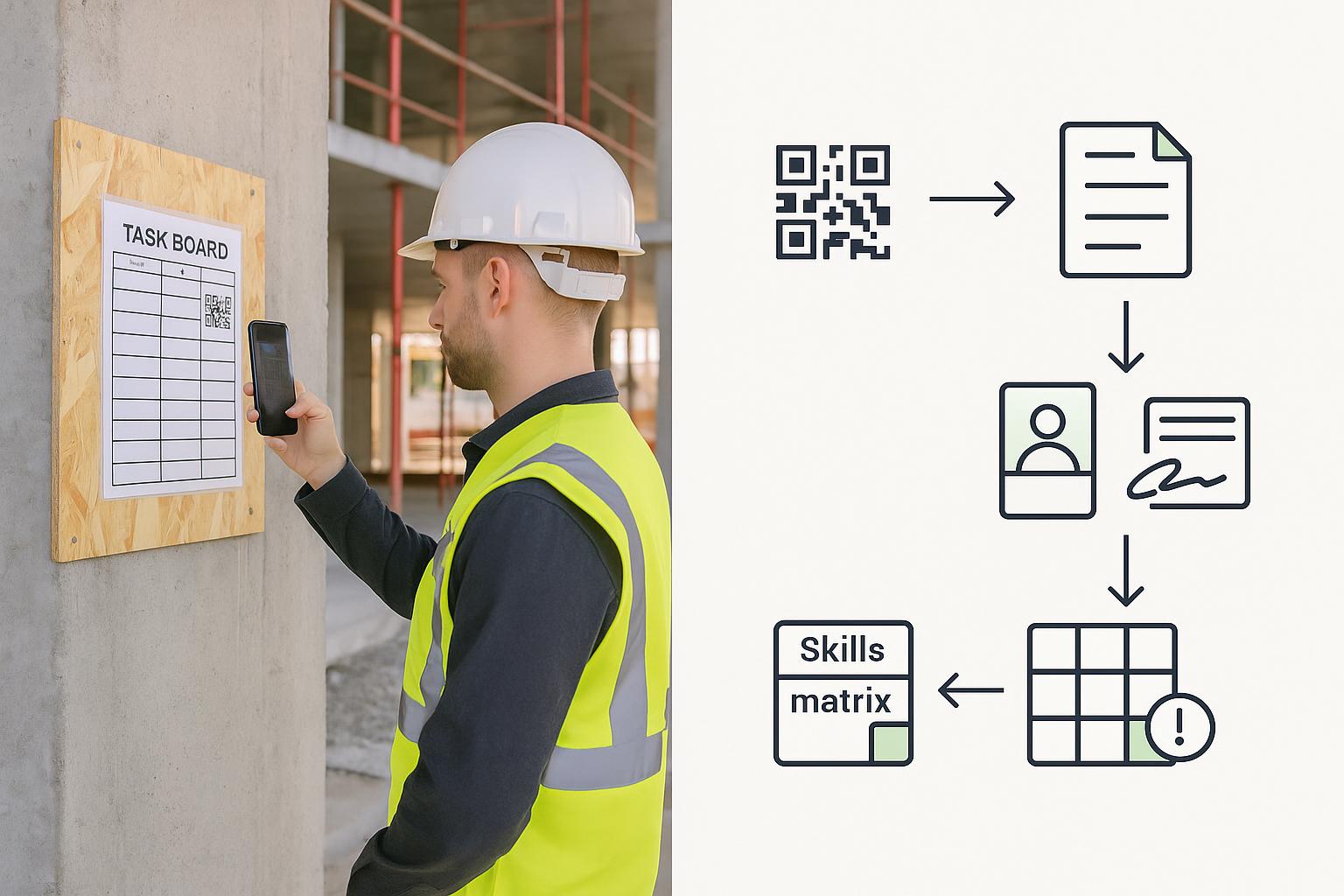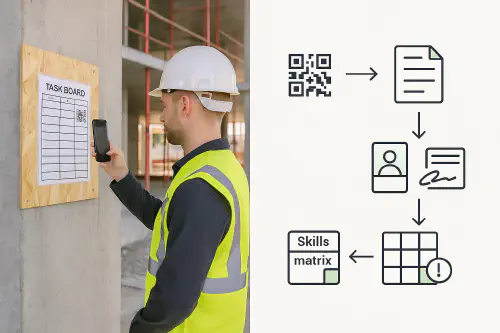
QR skills matrix for construction: live sign‑offs on site that update competence and block unsafe bookings
QR skills matrix for construction: live sign‑offs on site that update competence and block unsafe bookings
Category: Hiring, Training & HR • Niche: skills matrix, QR sign‑off, CSCS checks, microlearning, WhatsApp workflows, Airtable/Google Sheets
Contents
- Quick answer
- Who this is for
- How it works
- Step-by-step setup
- Capture the right evidence
- Make it stick on site
- Security and GDPR
- What are people saying on Reddit?
- FAQ

Supervisor scanning a QR at a task board; flow arrows to a form and live skills matrix update
Quick answer
You can run a live skills and training matrix without expensive software by giving every worker and high‑risk task a QR code that opens a prefilled form on a phone. Each scan logs who, where and when, captures a quick sign‑off (photo + signature), and updates a central matrix. Dispatch and scheduling can then check the matrix before assigning jobs so unsafe bookings are blocked.
- Uses tools you already know: Google Sheets or Airtable for the matrix; a simple form tool for capture; WhatsApp to nudge people.
- Meets UK expectations on competence evidence: combine card checks, training records and supervised sign‑offs. See HSE guidance on competence and CDM 2015 duties for skills, knowledge and experience. Read: HSE: What is competence?, CDM 2015 Reg 8.
- CSCS verification belongs at the door: scan cards with CSCS Smart Check and record the check method/date.
Who this is for
- Small to mid contractors who currently keep training records in a spreadsheet or ring‑binder.
- Firms that want clearer proof of competence and faster sign‑offs on busy sites.
- Businesses that dispatch engineers and need a quick way to stop unsafe job bookings.
How it works
- Worker QR: a badge or phone wallpaper that opens a prefilled form with their ID.
- Task/area QR: at the scaffold tag, MEWP charge bay, or hot‑work zone to log briefings and permits.
- Form submission writes to a central table. A rollup updates the latest sign‑off and flags gaps.
- Schedulers check the matrix (or an automation checks for you) before assigning jobs.
Diagram you can mirror on a whiteboard: Scan QR → Prefilled form opens → Photo + signature → Record in matrix → Scheduler sees green/amber/red.
Step-by-step setup
Pick a base (Airtable or Google Sheets) and one form tool (Airtable Forms, Google Forms, or Fillout). Airtable gives you nicer relationships between people, tasks and sign‑offs; Google is fine if you want simplest.
- Build the matrix
- People table/sheet: Name, Company, Role, CSCS number, Card expiry, Email, Phone, Unique ID, Evidence folder link. Add fields for key competencies by role.
- Sign‑offs table/sheet: Person, Task/Area, Site, Timestamp, Supervisor, Photo, Signature, Notes, Pass/Fail.
- Roles table (optional): Role → required tickets/training and refresh dates.
- Make the form
- Include hidden fields for Person ID and Site. Prefill them using query parameters. In Airtable use ENCODE_URL_COMPONENT to build safe prefill links. Guide: Airtable forms and prefill.
- Require a photo and signature on higher‑risk tasks.
- Generate the QR codes
- Option A: Make a unique prefilled URL per person and per recurring task/area, then convert to QR. miniExtensions has a simple Airtable QR generator. See: miniExtensions QR Code for Airtable.
- Option B: Use a short script to call a QR API and attach the image to your record.
- Put QRs where work happens
- Print worker badges and site posters. Add a QR to your scaffold tag board or hot‑work station with “Scan before starting.”
- For access control, verify cards with CSCS Smart Check. Store the check as an evidence note.
- Link to scheduling
- If you schedule from a calendar, create a simple rule: only book an engineer if the matrix shows green for that task in the last X months.
- If you use field apps, run a quick lookup against the matrix before dispatch. We show a full scheduling build in this article: Skills matrix for construction: link Google Sheets to your calendar to block unsafe bookings.
Optional automations
- 90/30/7 day reminders before CSCS/NPORS expiries.
- WhatsApp prompts after toolbox talks so crews submit the QR sign‑off. See our guide: Bilingual toolbox talks on WhatsApp.
- Incident → microlearning: turn a near miss into a 2‑minute refresher and require sign‑off next morning.
Capture the right evidence
HSE says competence is training, skills, experience and knowledge applied safely; supervision matters too. Use a mix:
- Identity and card checks: record CSCS or partner scheme check with Smart Check and date/time. CSCS Smart Check info: CSCS website.
- Tickets and training: NVQ, NPORS/CPCS, CISRS, IPAF, plus HS&E test where relevant. Map to CITB competence frameworks or your own risk‑based list. See: CITB Competence Frameworks.
- Task sign‑offs: short, supervised sign‑off with photo and signature for critical tasks or permits.
- Toolbox talks: keep proof of attendance and a quick quiz. HSE’s definition of a toolbox talk and free topics: HSE toolbox talks.
Make it stick on site
- One minute rule: the whole scan → photo → submit should take under a minute or it will be ignored.
- Put QRs at the point of work: scaffold tags, plant keys board, charging bays, hot‑work station.
- Supervisor of the day: rotate who chases missed scans; post daily compliance in WhatsApp.
- Version control: store your latest toolbox talk scripts and RAMS behind the same QR so crews always get the current version.
Real‑world examples you can learn from
- Balfour Beatty used QR‑coded permit armbands linked to BIM 360 so supervisors could verify permits on the spot. Read: Construction Management case note.
- Sisk at Wembley put QR codes at each flat handover point to access drawings and complete QA forms, cutting paper and delays. Read: BIM+ case study.
Security and GDPR
- Keep personal data to the minimum needed; state what you are collecting on the form and why.
- Restrict who can generate or edit QR codes; watermark posters and check for tampering. Be aware of QR scams in the UK and train staff to only scan trusted site posters.
- Store evidence in a secure drive with access by role. Delete outdated data in line with your retention policy.
What are people saying on Reddit?
- “Corporate toolbox talks are a joke” thread highlights the importance of short, relevant briefings and practical follow‑up rather than paperwork for its own sake. Read: r/electricians.
- Safety pros discuss adding mental health into toolbox talks, with simple prompts and signposting that crews actually use. Read: r/SafetyProfessionals.
FAQ
Is this accepted by UK clients and HSE?
Yes. HSE does not mandate a specific system; they want proportionate, risk‑based evidence of competence and supervision. QR sign‑offs plus CSCS checks and training records meet that bar when done properly. See: HSE competence and CDM 2015.
Do I need Airtable, or will Google Sheets do?
Sheets is fine for simple setups; Airtable makes relationships, photos and signatures smoother. You can start in Sheets and move later.
Can I prove attendance at toolbox talks with this?
Yes. Put a QR on your talk sheet; attendees scan, answer a 1‑question check, and sign. Store the record with the talk title and date. See HSE’s toolbox talk resource for topics: HSE toolbox talks.
Any video to help build the QR workflow?
This walkthrough shows QR creation, prefilled forms and reminders in Airtable: Airtable Maintenance Tracker – QR Codes, Automations and Forms.
How do I handle expiring cards and tickets?
Track expiry dates in the matrix and set 90/30/7 day reminders. If a card lapses, your scheduling rule should flip to red and block the booking until updated.
Want to slash training times and increase revenue per Engineer? Join our Waitlist: https://trainar.ai/waitlist